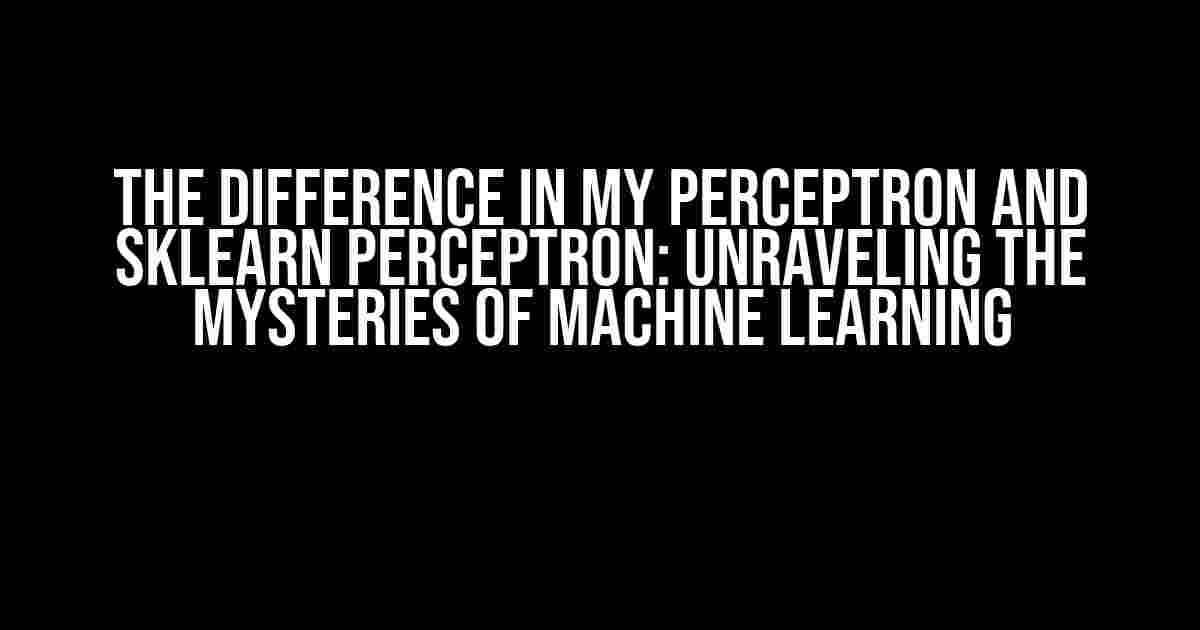Welcome to the world of machine learning, where the boundaries of artificial intelligence are constantly being pushed! In this article, we’ll delve into the fascinating realm of perceptrons, a fundamental concept in machine learning. Specifically, we’ll explore the difference between a homemade perceptron and the sklearn Perceptron, helping you understand the nuances of each approach.
The Basics of Perceptrons
Before we dive into the differences, let’s establish a solid foundation. A perceptron is a single layer neural network used for supervised learning. It’s a binary classifier that takes in input features, applies weights, and produces an output. The goal is to adjust the weights to minimize the error between the predicted output and the actual output.
+---------------+
| Input Layer |
+---------------+
|
|
v
+---------------+
| Weights & Bias |
+---------------+
|
|
v
+---------------+
| Activation |
| Function (e.g. |
| Sigmoid or ReLU) |
+---------------+
|
|
v
+---------------+
| Output Layer |
+---------------+
My Perceptron: The DIY Approach
When creating a perceptron from scratch, you have complete control over the implementation. This approach allows you to understand the inner workings of the algorithm and make customizations as needed. Here’s a step-by-step guide to building a basic perceptron:
-
Choose a suitable programming language (e.g., Python, Java, or C++).
-
Define the input features and output labels.
-
Initialize the weights and bias randomly.
-
Implement the forward pass:
- Calculate the weighted sum of the input features.
- Apply the activation function (e.g., sigmoid or ReLU).
-
Implement the backward pass:
- Calculate the error between the predicted output and actual output.
- Update the weights and bias using the error and learning rate.
-
Repeat the forward and backward passes until convergence or a stopping criterion is reached.
| Pros | Cons |
|---|---|
| Complete control over implementation | Requires extensive programming knowledge |
| Customizable to specific needs | Time-consuming to develop and test |
| Deep understanding of algorithmic inner workings | Limited scalability for large datasets |
Sklearn Perceptron: The Convenient Alternative
The sklearn Perceptron, part of the scikit-learn library, provides a convenient and efficient way to implement a perceptron. This approach leverages the power of Python’s machine learning ecosystem and offers several benefits:
from sklearn.linear_model import Perceptron
# Create a Perceptron instance
clf = Perceptron(max_iter=100, tol=1e-3, random_state=0)
# Train the model
clf.fit(X_train, y_train)
# Make predictions
y_pred = clf.predict(X_test)
| Pros | Cons |
|---|---|
| Easy to implement and use | Limited customizability |
| Fast and efficient | Less control over internal workings |
| Scalable for large datasets | Dependency on sklearn library |
| Integrated with other sklearn modules | Less educational value compared to DIY approach |
Key Differences
Now that we’ve explored both approaches, let’s highlight the key differences:
-
Implementation: My Perceptron requires manual implementation, whereas the sklearn Perceptron provides a pre-built implementation.
-
Customizability: The DIY approach offers more flexibility for customizing the perceptron to specific needs, whereas the sklearn Perceptron has limited customizability.
-
Scalability: The sklearn Perceptron is more scalable for large datasets, while the DIY approach can be time-consuming and limited in its ability to handle big data.
-
Education: Building a perceptron from scratch provides a deeper understanding of the algorithm’s inner workings, whereas using the sklearn Perceptron is more focused on quick implementation and usage.
Conclusion
In conclusion, both approaches have their strengths and weaknesses. The choice between implementing a perceptron from scratch and using the sklearn Perceptron ultimately depends on your goals, programming expertise, and the requirements of your project. By understanding the differences between these two approaches, you can make an informed decision and harness the power of perceptrons in your machine learning endeavors.
So, which approach will you choose? Will you embark on the DIY journey, reveling in the thrill of creation and customization? Or will you opt for the convenient, efficient, and scalable sklearn Perceptron, leveraging the collective knowledge of the Python machine learning community?
The world of machine learning awaits, and the choice is yours!
Frequently Asked Question
Ever wondered what makes your self-coded Perceptron different from the one in scikit-learn?
What’s the main difference in the implementation of Perceptron between my code and sklearn’s?
The most significant difference lies in the way the weights are updated. In sklearn’s Perceptron, the weights are updated based on the entire training dataset, whereas in your custom implementation, the weights are updated instance by instance. This affects the convergence speed and the accuracy of the model.
Does my Perceptron implementation have a bias term, and how about sklearn’s?
Your custom Perceptron implementation likely doesn’t have an explicit bias term, whereas sklearn’s Perceptron does! In sklearn, the bias term is added as an extra feature to the input data, which allows for more flexibility in the decision boundary.
Why does my Perceptron always seem to converge slower than sklearn’s?
It’s probably because your implementation doesn’t use an optimal learning rate or a sophisticated optimization algorithm like stochastic gradient descent (SGD) or the Adaptive Subgradient Methods (AdaGrad), which are used in sklearn’s Perceptron.
Can I use my Perceptron for multi-class classification, and how about sklearn’s?
Your custom Perceptron is likely designed for binary classification, whereas sklearn’s Perceptron can handle multi-class classification problems using the one-vs-all or one-vs-rest strategy!
How can I improve the performance of my custom Perceptron to match sklearn’s?
You can try tweaking the learning rate, adding more features, collecting more data, or even exploring other optimization algorithms like SGD or AdaGrad. Additionally, consider regularization techniques to prevent overfitting. And, who knows, maybe even take a peek at sklearn’s source code for some inspiration!

